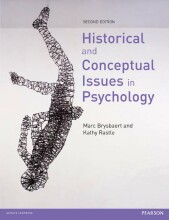Hemispheric Specialization
16 important questions on Hemispheric Specialization
In the 19th century, the lateralization of language was discovered, what was the reason they thought the lateralization was related to anatomical differences?
- it was noted that the Sylvian Fissure was much flatter on the left than on the right
- This corresponds to differences in the size of Heschl’s gyrus and the Planum Temporale
- heschl's gyrus and the planum temporale corresponds to (form) Wernicke’s area
How is shown that the lateralization of language is not due to anatomical differences between the hemispheres?
- Size of left vs right Heschl’s gyrus does not match to language lateralization as measured using Wada test.
- People with right hemisphere speech dominance (RSG) or bilateral speech (BSG) also have larger left sided Heschl’s gyrus, as do left hemisphere speech dominance people (LSG)
What are other differences between left and right language areas? (language area, and the opposite area where the language area should've been.)
- Pyramidal cell bodies are larger on the left than on the right in Heschl’s gyrus
- Connections between cells are organized in patches, these patches are equally large in left and right hemisphere, but they are more distant apart in the left than in the right
- Higher grades + faster learning
- Never study anything twice
- 100% sure, 100% understanding
How do we call the structure that connects the cortexes of the two hemispheres enabling them to work together?
The corpus callosum generally makes homotopic connections, but sometimes also heterotopic connections, what does this mean?
- homotopic; connection between an area with the same area on the other side
- heterotopic; area connecting to different areas on the other side.
Describe the experiment on interhemispheric connectivity with light bars as visual stimuli.
- measure a neurons on both hemispheres with a similar receptive field.
- showing two bars moving in opposite directions, causes nonsynchronized firing of the neurons
- showing one long light bar spanning both receptive fields moving in one direction causes synchronized firing of the neurons
- cut the corpus callosum, and show the long bar again, nonsynchronized firing of the neurons will follow.
Back in the day, what was the reason to cut a corpus callosum?
- a person suffering from severe epilepsy (they didn't have medicine yet)
- did work though.
Why did people initially thought the corpus callosum was useless?
- after cut psychological tests revealed no pronounced changes in personality, intellect, sensory or motor performance
What happens when the corpus callosum is fully cut and a word is presented in the left visual field?
- Objects or words presented to the right hemisphere (left visual field) are not ‘seen’ (verbally reported),
- yet the left hand can point to or select these objects from an array of objects, draw the object, match it to words
What are advantages shown in patients with a cut corpus callosum?
- patients are better at multitasking with both hands
- The two hemispheres can independently search for a visual target, In split brain, search times increase with ~ half the slope, when items presented to two hemispheres
With split brain patients you can investigate which hemisphere is better at a certain task; which hemisphere is better at recognizing (matching) faces?
When do you see that the left hemisphere is just as good as the right hemisphere in recognizing faces?
- when there're more cues present in the stimuli (e.g. hair colour, or hair style, compared to just faces)
- this way the left hemisphere can make verbal descriptions of the face and therefor recognize.
Which hemisphere is responsible for (perceptual) feature integration, seeing the bigger picture, perceptual organization etc?
How is shown that the right hemisphere is drawn to "global" information?
- when presented with hierarchical letter stimuli, split brain patients either get two tasks; name the global letter, or name the local letter.
- when the stimuli are presented in the right visual field they're much better at naming the local letter, but not the global letter.
- when the stimuli are presented in the left visual field they're much better at naming the global letter, but not the local letter
What happens when patients with lesions to either the right or left hemispheres have to copy hierarchical letter stimuli?
- patient with lesion on the right hemisphere will draw a lot of local letters without any shape.
- patients with lesions on the left hemisphere will just draw the global letter, without any local letters.
Which hemisphere is responsible for reasoning, rationalization, analyzing, seeking patterns, etc?
The question on the page originate from the summary of the following study material:
- A unique study and practice tool
- Never study anything twice again
- Get the grades you hope for
- 100% sure, 100% understanding
































